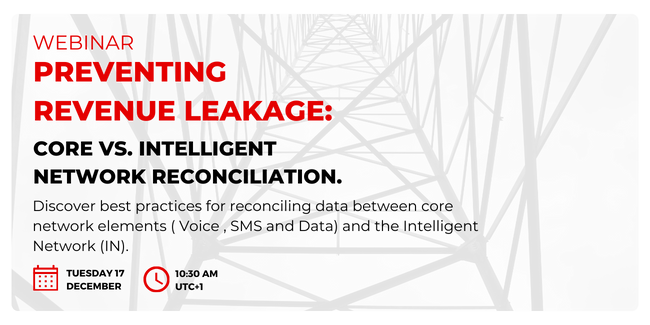Introduction
Ensuring revenue assurance and operational efficiency has become a top priority for telecom operators. With the increasing complexity of telecom services—spanning voice, SMS, data, and now 5G networks—the risks of revenue leakage have never been higher. Reconciliation, the process of aligning data across core and intelligent network elements, emerges as a powerful tool to combat these challenges.
The Scope of Revenue Leakage in Telecom
Revenue leakage is a widespread issue, costing telecom operators up to $135 billion annually, according to industry studies. These losses arise from various sources:
- System integration issues between core network elements (e.g., MSC, GGSN, SGW) and intelligent network systems (IN).
- Manual errors during reconciliation processes.
- Outdated or misconfigured billing systems, resulting in missed charges or incorrect invoices.
For example, discrepancies in call detail records (CDRs) or usage detail records (UDRs) can lead to unbilled services or overcharges, which not only affect revenue but also erode customer trust.
Why Reconciliation Matters
Reconciliation ensures that the data flowing between different telecom network components is accurate, consistent, and up-to-date. It’s particularly critical for services like:
- Voice: Matching CDRs from the Mobile Switching Center (MSC) with the IN system to ensure proper billing for calls.
- SMS: Aggregating fragmented SMS records for accurate reconciliation.
- Data Services: Aligning data usage records from GGSN/SGW with billing systems to prevent unbilled data usage.
Core Benefits:
Accurate Billing: Operators can ensure that every service is accounted for, reducing overcharges or undercharges.
Fraud Prevention: Reconciliation helps identify anomalies, such as SIM box fraud or call bypass incidents.
Operational Efficiency: Automation in reconciliation processes reduces manual intervention and minimizes errors.
Regulatory Compliance: Accurate reporting ensures that operators meet strict compliance requirements.
How Reconciliation Boosts Efficiency
By eliminating inconsistencies, reconciliation streamlines telecom operations. Here’s how it drives efficiency:
Real-Time Data Matching: Advanced tools like Apache Spark allow operators to match millions of records in real time, detecting discrepancies instantly.
Automation: Robotic Process Automation (RPA) eliminates repetitive tasks, freeing up teams to focus on strategic initiatives.
Scalability: With telecom networks expanding to accommodate 5G and IoT, reconciliation tools can handle higher data volumes and new service models.
Cross-Department Collaboration: By aligning billing, operations, and network teams, reconciliation fosters a unified approach to revenue assurance.
The Role of Big Data and AI
Emerging technologies like Big Data and Artificial Intelligence (AI) are revolutionizing reconciliation processes. AI-powered tools enable operators to:
Predict Revenue Risks: Machine learning algorithms analyze patterns to detect potential revenue leaks before they occur.
Streamline Fraud Detection: Behavioral analytics can identify irregularities, such as unusually high data usage or unexpected call patterns.
Optimize Service Delivery: Real-time insights from Big Data ensure that services are delivered as promised, maintaining high customer satisfaction.
A Practical Example
Consider a scenario where an operator authorizes a data session but fails to reconcile the actual usage due to delays in record synchronization. Without proper reconciliation, the operator could miss billing for part of the session, leading to significant revenue loss. Implementing a reconciliation system that uses real-time data synchronization would resolve this issue efficiently.
Watch our Webinar: Preventing Revenue Leakage: Core vs. Intelligent Network Reconciliation.
Want to learn more about data reconcialition between core and intelligent network? Watch our insightful webinar

📺 Watch the Webinar Recording Now
Key Takeaways from the Webinar
- Data reconciliation is essential for ensuring revenue assurance and preventing revenue leakage.
- Challenges vary across network elements, but scalable, vendor-agnostic solutions simplify the process.
- Accurate reconciliation requires enriching datasets with external information like KYC data.
- Collaboration between network teams and revenue assurance specialists is crucial for success.
Conclusion
Successful reconciliation is not just about preventing revenue leakage; it’s about creating a resilient, customer-focused telecom ecosystem. By leveraging advanced tools, automating processes, and fostering collaboration across departments, telecom operators can unlock higher revenue potential while boosting operational efficiency.
Adopting these best practices ensures that as the telecom industry evolves, operators are well-equipped to tackle its challenges and seize its opportunities.


